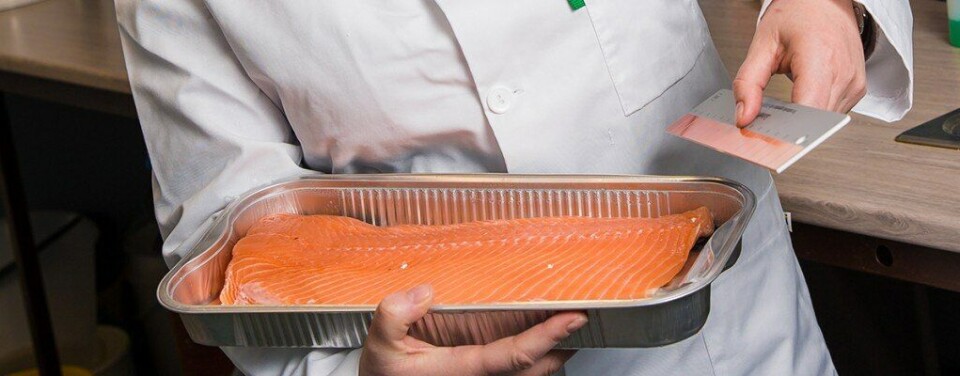
Beyond the pale
Scientists at Nofima have found that low levels of omega-3s in feeds and high levels of stress both have a negative impact on the colour of farmed salmon fillets.
Pigment and antioxidant
Astaxanthin, a pigment that gives salmon fillets their colour and which is also a powerful antioxidant, has a positive effect on the defence mechanisms that mammals use against stress and disease. Animals cannot produce astaxanthin naturally. Algae in the sea that can produce astaxanthin are eaten by crustaceans, which are in turn eaten by fish such as salmon. It is, therefore, necessary to add colouring agents to the feed of salmon raised in aquaculture.
While the use of astaxanthin in salmon feed has increased, the amounts that remain in the muscles of Norwegian farmed salmon are relatively low. Scientists at Nofima have carried out experiments that have shown that the level of omega-3 in the feed contributes to determining the quality of the colour uptake. They have also discovered that stress may play a confounding role in the interaction between colour and diet. Scientist Trine Ytrestøyl at Nofima wants to investigate this in more detail.
Understanding the interactions
Ytrestøyl’s research has shown that the level of omega-3 in feed affects the colour of the salmon, and has suggested that stress also plays a role.
“It has previously been shown that marine omega-3 has a positive effect on colour, but no-one has known why. Further, the role that stress plays in the interaction between omega-3 and astaxanthin is not understood,” says Ytrestøyl.
“Our hypothesis is that when the feed has a low level of marine omega-3 while the salmon are exposed to stress, the fish metabolise a larger amount of the antioxidant astaxanthin. This results in a less intense colouration of the fillet,” continues Ytrestøyl.
One of the breakdown products from astaxanthin is idoxanthin. The scientists have found that the level of idoxanthin increases when that of astaxanthin falls, if the level of marine omega-3 in the feed is at the same time low. They have also shown that there is a relationship between the genes involved in the metabolism of astaxanthin and the level of marine omega-3 in the feed.
Stress experiments
Salmon growing from 40 grams to 3.5 kilograms were given feeds with different levels of marine omega-3.
All the fish were exposed to stress during the transfer from land- to sea-based facilities, and this gave valuable insights into how stress affected groups of fish that had received different levels of marine omega-3 in the feed.
The experiments showed the growth of all groups of salmon that had received feed with different levels of omega-3 was satisfactory. The colouration of the fillets, in contrast, decreased with decreasing levels of omega-3 in the feed, while more astaxathin was converted to idoxanthin. Fish fed with a low level of omega-3 also had a lower survival rate than fish that received more omega-3.
“Previous projects have also shown that stressed fish have more idoxanthin than fish that have not experienced high stress. Even so, we do not understand in detail how stress affects quality, and we need more knowledge about the effect of the interplay between feed and the environment, and the needs of the fish for antioxidants and other nutrients in practical aquaculture,” says Ytrestøyl.
One challenge is that many factors influence the colouration of the fillets. There is little fundamental knowledge about how astaxanthin is converted to other compounds and metabolised as an antioxidant in the salmon, and about how the environment influences the metabolism and absorption of astaxanthin.
Consequences of feed changes
The fraction of marine raw materials in salmon feed has been reduced in recent years. The feed of Norwegian farmed salmon consisted of 90% marine raw materials in 1990. The fraction had been reduced to 29.2% by 2013. This trend has continued, and the fraction of marine raw materials is now probably lower than it was in 2013. These figures are from a report written by Ytrestøyl and her colleagues in 2014, based on documentation from the feed manufacturers.
“The limited commercial access to marine omega-3 means that we must know the consequences for fish health and quality that arise if the level in the feed is further reduced from the current level,” concludes Ytrestøyl.























































